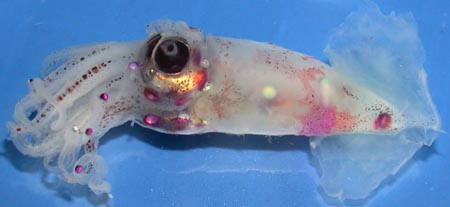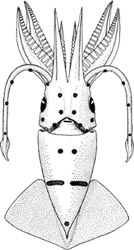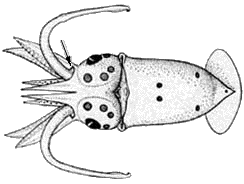Lampadioteuthis
Lampadioteuthis megaleia
Richard E. Young and Michael VecchioneIntroduction
L. megaleia is a small, colorful squid that differs from other lycoteuthids, among other characters, in the presence of a hectocotylus and a rostrum on the gladius.Diagnosis
A lycoteuthid...
- with four ocular photophores.
- with stalked photophores at base of tentacles.
Characteristics
- Arms
- Right ventral arm hectocotylized in males with enlarged protective membrane in mid-arm.
image info
Figure. Oral view of hectocotylus of L. megaleia, 31 mm ML. Drawing from Young (1964, p. 449).
- Right ventral arm hectocotylized in males with enlarged protective membrane in mid-arm.
- Photophores.
- Four ocular organs: 3 ventral in a line, 1 lateral.
- Five tentacular organs, basal organ raised above stalk.
 image info
image info Figure. Ventral view on anterior portion of head and base of brachial crown of a 27 mm ML L. megaleia. Arrows point to stalks of basal tentacle photophores. Photograph by R. Young, R/V G. O. Sars, Mar-Eco cruise, central North Atlantic.
- Branchial photophores transversely elongate.
- Abdominal photophores absent.
- Postero-abdominal photophore single.
 image info
image info Figure. Ventral view of the mantle of a damaged L. megaleia, 27 mm ML, showing the visceral photophores through the translucent muscle. The elongate right branchial photophore has a bluish region at one end. Photograph by R. Young, R/V G. O. Sars, Mar-Eco cruise, central North Atlantic.
- Pigmentation
- Squid with numerous functional chromatophores.
- External skin overlying photophores with violet pigment.
 image info
image infoFigure. Ventro-lateral view of L. megaleia, same specimen as in title photograph. Note the violet patches on the mantle covering the posterior visceral photophores (skin over the anal photophores has been lost due to damage), the ocular photophores (damage has moved the skin away from some photophores) and the tentacular photophores.
- Gladius
- Rostrum present.
 image info
image info Figure. Gladius of L. megaleia, 18.5 mm GL, USNM 727882. Upper left - Ventral view of posterior mantle and fins showing rostrum and conus of gladius. Lower right - Ventral view of gladius with cross-sections. Drawings from Toll (1982).
- Rostrum present.
- Viscera
- Single penis present in males.
Comments
Drawings of the tentacular club and the club and arm suckers can be found here.
The violet pigment overlying the photophores presumably acts as a color filter to allow the bioluminescence to more closely match the color of the downwelling sun or moonlight. The same type of "detached" filter appears to be present in the photophores of species of Lycoteuthis.
Life History
Advanced paralarvae (Young, 1964) are similar to subadults except for some differences in body proportions, size of photophores and the absence of all but the large basal photophore on the tentacle. Note presence of this photophore at the base of the tentacle in the drawing (arrow).Figure. Ventral view of an 8 mm paralarva. Drawing from Young, 1964.
Distribution
Type locality: Washed ashore at Sunday Island, Kermadec Islands, South Pacific. This species is known from the subtropical North Atlantic and the Southwestern Pacific (Nesis, 1982/87).
References
Nesis, K. N. 1982/87. Abridged key to the cephalopod mollusks of the world's ocean. 385+ii pp. Light and Food Industry Publishing House, Moscow. (In Russian.). Translated into English by B. S. Levitov, ed. by L. A. Burgess (1987), Cephalopods of the world. T. F. H. Publications, Neptune City, NJ, 351pp.
Voss, G. L. 1962. A monograph of the Cephalopoda of the North Atlantic. I. The Family Lycoteuthidae. Bull. Mar. Sci. Gulf Carib. 12: 264-305.
Young, R.E. 1964. A note on three specimens of the squid, Lampadioteuthis megaleia Berry, 1916 (Cephalopoda:Oegopsida) from the Atlantic Ocean, with a description of the male. Bull. Mar. Sci. Gulf Carib., 14(3):444-452.
Title Illustrations
| Scientific Name | Lampadioteuthis megaleia |
|---|---|
| Comments | Photographed aboard the R/V G. O. Sars, Mar-Eco cruise, central North Atlantic. |
| View | Ventrolateral |
| Copyright | © 2004 Richard E. Young |
| Scientific Name | Lampadioteuthis megaleia |
|---|---|
| Reference | Young, R.E. 1964. A note on three specimens of the squid, Lampadioteuthis megaleia Berry, 1916 (Cephalopoda:Oegopsida) from the Atlantic Ocean, with a description of the male. Bull. Mar. Sci. Gulf Carib., 14(3):444-452. |
| Acknowledgements | Printed with the Permission of the Bulletin of Marine Science. |
| View | Ventral |
| Copyright | © 2004 Richard E. Young |
About This Page
Drawings printed with the Permission of the Bulletin of Marine Science.
Richard E. Young
Dept of Oceanography
University of Hawaii
Honolulu, Hawaii 96822
USA
National Marine Fisheries Service
Systematics Laboratory
National Museum of Natural History
Washington, D. C. 20560
USA
Page copyright © 1999 Richard E. Young and
Citing this page:
Young, Richard E. and Vecchione, Michael. 1999. Lampadioteuthis . Lampadioteuthis megaleia . Version 01 January 1999 (complete). http://tolweb.org/Lampadioteuthis_megaleia/19730/1999.01.01 in The Tree of Life Web Project, http://tolweb.org/












